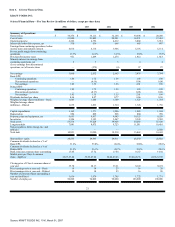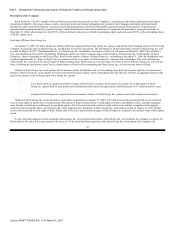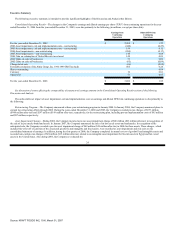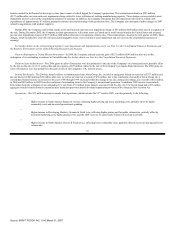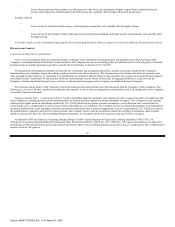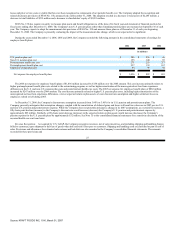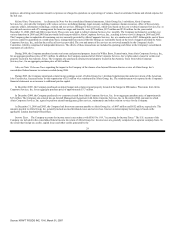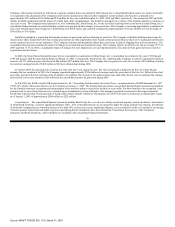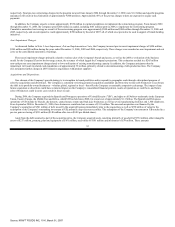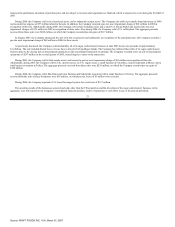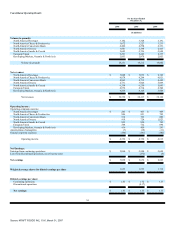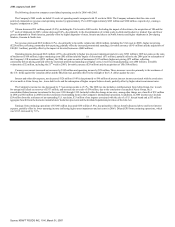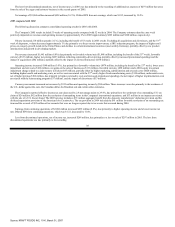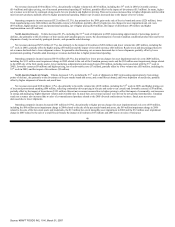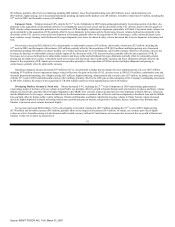Kraft 2006 Annual Report Download - page 35
Download and view the complete annual report
Please find page 35 of the 2006 Kraft annual report below. You can navigate through the pages in the report by either clicking on the pages listed below, or by using the keyword search tool below to find specific information within the annual report.
Business Environment
The Company is subject to a number of challenges that may adversely affect its businesses. These challenges, which are discussed below and under the
"Risk Factors" section in Part 1, Item 1A of this Annual Report on Form 10-K, include:
•
fluctuations in commodity prices;
•
movements of foreign currencies;
•
competitive challenges in various products and markets, including price gaps with competitor products and the increasing
price-consciousness of consumers;
•
a rising cost environment and the limited ability to increase prices;
•
a trend toward increasing consolidation in the retail trade and consequent pricing pressure and inventory reductions;
•
a growing presence of discount retailers, primarily in Europe, with an emphasis on own-label products;
•
changing consumer preferences, including diet and health/wellness trends;
•
competitors with different profit objectives and less susceptibility to currency exchange rates; and
•
increasing scrutiny of product labeling and marketing practices as well as concerns and/or regulations regarding food safety, quality and
health, including genetically modified organisms, trans-fatty acids and obesity. Increased government regulation of the food industry could
result in increased costs to the Company.
In the ordinary course of business, the Company is subject to many influences that can impact the timing of sales to customers, including the timing of
holidays and other annual or special events, seasonality of certain products, significant weather conditions, timing of Company or customer incentive programs
and pricing actions, customer inventory programs, Company initiatives to improve supply chain efficiency, financial condition of customers and general
economic conditions.
Fluctuations in commodity costs can lead to retail price volatility and intense price competition, and can influence consumer and trade buying patterns.
During 2006, the Company's commodity costs on average were higher than those incurred in 2005 (most notably higher coffee, energy and packaging costs,
partially offset by lower cheese and meat costs), and adversely affected earnings. For 2006, the Company's commodity costs were approximately $275 million
higher than 2005, following an increase of approximately $800 million for 2005 compared with 2004.
Restructuring:
In January 2004, the Company announced a three-year restructuring program (which is discussed further in Note 3.Asset Impairment, Exit and
Implementation Costs) with the objectives of leveraging the Company's global scale, realigning and lowering its cost structure, and optimizing capacity
utilization. In January 2006, the Company announced plans to expand its restructuring efforts through 2008. The entire restructuring program is expected to result
in $3.0 billion in pre-tax charges, the closure of up to 40 facilities, the elimination of approximately 14,000 positions and annualized cost savings at the
completion of the program of approximately $1.0 billion. The decline of $700 million from the $3.7 billion in pre-tax charges previously announced was due
primarily to lower than projected severance costs, the cancellation of an initiative intended to generate sales efficiencies, and the sale of one plant that was
originally planned to be closed. Approximately $1.9 billion of the $3.0 billion in pre-tax charges are expected to require cash payments. Total pre-tax
restructuring program charges incurred, including implementation costs, were $673 million, $297 million and $641 million in 2006, 2005 and 2004,
31
Source: KRAFT FOODS INC, 10-K, March 01, 2007


